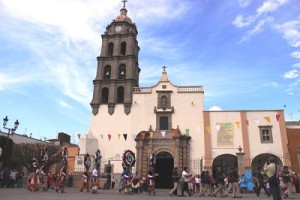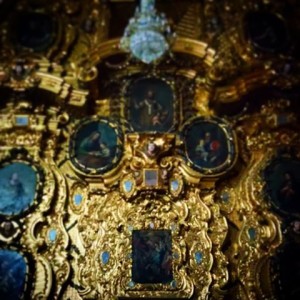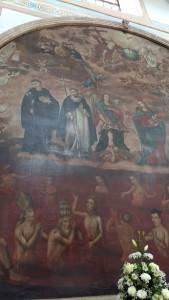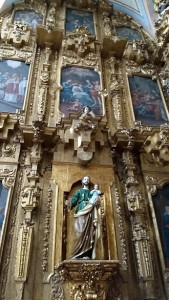Recently the state’s director of tourism invited me down to nearby Comonfort to explore the churches there with him. He is tasked with increasing tourism to the state’s many religious sites, in particular in Comonfort, and wanted my thoughts being the nearby expert in San Miguel.
Sure, I was flattered, but, more so, intrigued to see what could make Comonfort’s churches in some way different than those here in town.
The main church is St. Francis featuring several twists. It is the first church anywhere I’ve seen with a constant display of the Eucharist, or communion wafer. When displayed the Eucharist holds your devotion, or at least your attention, and you don’t turn your back on it. Something I got repeatedly chastised for as I was way more interested in the painting across from the chapel featuring life sized characters.
The painting is very popular, featured in our own Parroquia, but I’ve never seen it so large and life-sized. The story focuses on Mary and St. Michael handing picking folks to yank out of the Hell beneath their feet. If you were an indigenous painter during the Colonial Era, to poke fun at conquering Spanish, you’d place clergy in hell. The image features a pope and bishops in their towering hats among the flames.
On both sides of the altar are the ever present image Jesus’ parents, Mary and Joseph. Like in our Immaculate Conception church their lives are depicted in about a dozen paintings to be viewed chronologically in a clock wise fashion. Mary’s pictorial biography is easy to follow but her spouse’s, Joseph’s, is a bit more complex since so little is known about him.
Two paintings are particularly interesting. One is Jesus’ circumcision. I understand why that was a big day for Jesus but as the father of circumcised boys, not so much for Dad.
The last painting is Joseph’s death as he lies in bed and Joseph touches his cheek. Since Joseph was Jesus’ step-father death could not touch him. However it came time for Joseph to go on to eternal life which was only possible once Jesus grazed his cheek. Since when we die, we’ve the opportunity of meeting Jesus and Mary, while Joseph had to die leaving them behind here on Earth, it is considered a difficult death. This event makes Joseph the patron of a good death.
The most fascinating part of the church are images of clouds and saints to the left of the altar. The wall is lined with mirrors to reflect the sunrise from an across the altar’s aisle window. As the sun rises the light is reflected in the mirrors literally traveling from heaven down to the bottom mirrors reflecting the local Otomi’s image reminding he or she that their destiny is to be in Heaven with all the featured saints. An eloquent message communicated without any words.
By the railroad tracks is the church for Mary of Good Help very obviously built upon the remains of a step pyramid. The Spanish always build churches where the indigenous were use to worshipping, I’m only surprised this time they didn’t whip the stones off the pyramid to build the church.
Mary of Good Health was the version of Mary on the side of the Spanish during the Revolution. Obviously a betting man would put his money on Guadalupe, the mother of all of Mexico, who was on the winning side.
 My favorite church in town is actually above town. I’ve met the now elderly man that built the chapel of Divine Mercy overlooking town. He faithfully brought the building materials and art to honor an image of Jesus that forgives all and insists anything is possible. The views of town and neighboring archeological sites are stunning but require the cardio level of a billy goat to access. Reaching the chapel caused me to discover parts of my body could sweat that I had no idea performed any function whatsoever beyond a bit of buoyancy.
My favorite church in town is actually above town. I’ve met the now elderly man that built the chapel of Divine Mercy overlooking town. He faithfully brought the building materials and art to honor an image of Jesus that forgives all and insists anything is possible. The views of town and neighboring archeological sites are stunning but require the cardio level of a billy goat to access. Reaching the chapel caused me to discover parts of my body could sweat that I had no idea performed any function whatsoever beyond a bit of buoyancy.
Comonfort’s churches, like San Miguel’s are endlessly fascinating!
Joseph Toone is the Historical Society’s short-story award winning author of the SMA Secrets book series. All books in the series are Amazon bestsellers in Mexican Travel and Holidays. Toone is SMA’s expert and TripAdvisor’s top ranked historical tour guide telling the stories behind what we do in today’s SMA. Visit HistoryAndCultureWalkin


